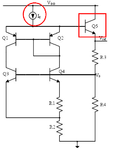dominoeff
Junior Member level 1
- Joined
- May 6, 2010
- Messages
- 17
- Helped
- 0
- Reputation
- 0
- Reaction score
- 0
- Trophy points
- 1,281
- Location
- china-mainland
- Activity points
- 1,413
Hi Guys:
I am working on a bandgap circuit for a internal regulator in a DC-DC converter. The core circuit is a simple BROKAW bandgap circuit and i need a startup circuit for it.The problem is the input voltage is from 5~23 and the high voltage MOSFET my process provide have a max Gate-Source voltage(Vgs) of 5,while the max Base-Emitter(Vbe) voltage of 10.
Any suggestion or any paper reference is highly appreciated.
Thanks all.
Dominoeff
I am working on a bandgap circuit for a internal regulator in a DC-DC converter. The core circuit is a simple BROKAW bandgap circuit and i need a startup circuit for it.The problem is the input voltage is from 5~23 and the high voltage MOSFET my process provide have a max Gate-Source voltage(Vgs) of 5,while the max Base-Emitter(Vbe) voltage of 10.
Any suggestion or any paper reference is highly appreciated.
Thanks all.
Dominoeff
